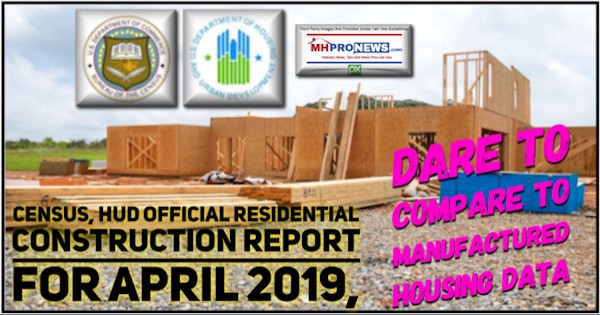
Our publisher was laughing this morning after he read an email. When asked what the joke was, he replied by showing a pro-Manufactured Housing Institute trade media outlet that was announcing their ‘State of the Industry’ upcoming report. “The state of the industry can be summed up by statistics,” said L. A. ‘Tony’ Kovach, as the laughter faded, replaced by a sober look, “which reflects the dismal reality that during an affordable housing crisis, manufactured housing is selling fewer homes today than 15 years ago, when Warren Buffett’s Berkshire Hathaway entered the manufactured home industry by buying Clayton Homes. Coincidence?”
He added two question. “Do you think that trade publisher will look at the underlying issues or evidence that have contributed to the industry’s decline? Or do you think they will be doing more cheerleading, as more slow-motion consolidation takes place?”
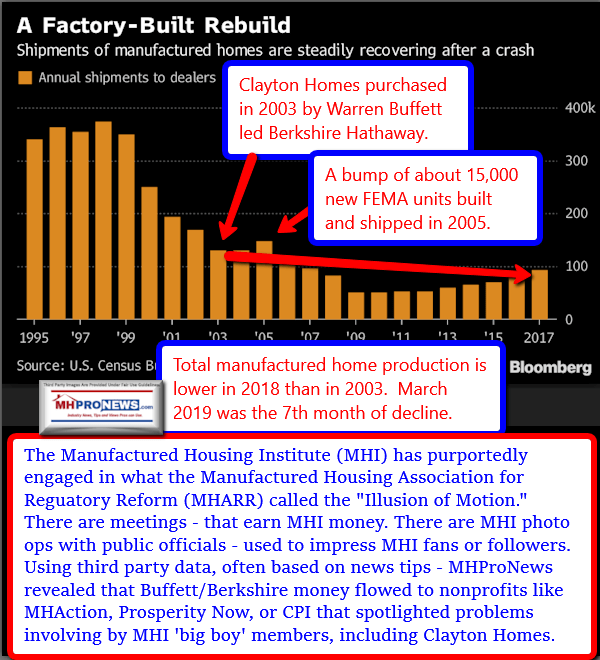
Time will tell what the pro-MHI echo chamber might produce next. We’ll plan to report on what their latest spin on reality might be.
That said, HUD’s and the U.S. Census Bureau’s Residential Construction report for April, 2019 is out this morning. Following their data-driven report, there will be a recap of HUD’s new manufactured home shipment data.
U.S. Dept. of Housing and Urban Development (HUD) U.S. Census Bureau
May 16, 2019
HUD AND CENSUS BUREAU REPORT RESIDENTIAL CONSTRUCTION ACTIVITY IN APRIL 2019
WASHINGTON – The U.S. Department of Housing and Urban Development (HUD) and the U.S. Census Bureau jointly announced the following new residential construction statistics for April 2019.
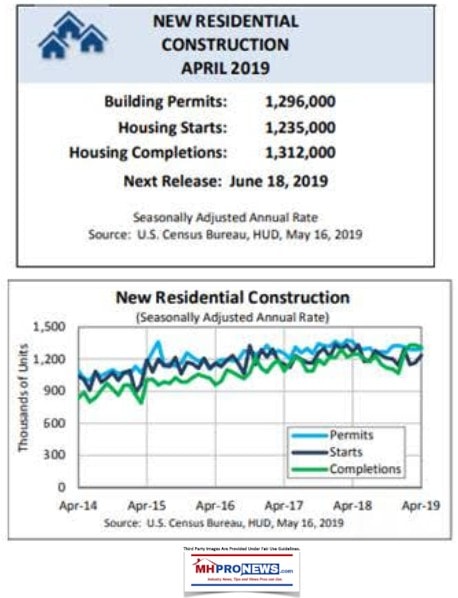
Building Permits
Privately owned housing units authorized by building permits in April were at a seasonally adjusted annual rate of 1,296,000. This is 0.6 percent (±2.6 percent)* above the revised March rate of 1,288,000, but is 5.0 percent (±1.4 percent) below the April 2018 rate of 1,364,000. Single‐family authorizations in April were at a rate of 782,000; this is 4.2 percent (±1.2 percent) below the revised March figure of 816,000. Authorizations of units in buildings with five units or more were at a rate of 467,000 in
April.
Housing Starts
Privately owned housing starts in April were at a seasonally adjusted annual rate of 1,235,000. This is 5.7 percent (±13.0 percent)* above the revised March estimate of 1,168,000, but is 2.5 percent (±10.4 percent)* below the April 2018 rate of 1,267,000. Single‐family housing starts in April were at a rate of 854,000; this is 6.2 percent (±13.7 percent)* above the revised March figure of 804,000. The April rate for units in buildings with five units or more was 359,000.
Housing Completions
Privately owned housing completions in April were at a seasonally adjusted annual rate of 1,312,000. This is 1.4 percent (±15.5 percent)* below the revised March estimate of 1,331,000, but is 5.5 percent (±11.9 percent)* above the April 2018 rate of 1,244,000. Single‐family housing completions in April were at a rate of 918,000; this is 4.1 percent (±13.4 percent)* below the revised March rate of 957,000. The April rate for units in buildings with five units or more was 381,000. The February report is scheduled for release on March 26, 2019.
EXPLANATORY NOTES
In interpreting changes in the statistics in this release, note that month-to-month changes in seasonally adjusted statistics often show movements which may be irregular. It may take three months to establish an underlying trend for building permit authorizations, six months for total starts, and six months for total completions. The statistics in this release are estimated from sample surveys and are subject to sampling variability as well as nonsampling error including bias and variance from response, nonreporting, and undercoverage. Estimated relative standard errors of the most recent data are shown in the tables. Whenever a statement such as “2.5 percent (±3.2 percent) above” appears in the text, this indicates the range (-0.7 to +5.7 percent) in which the actual percentage change is likely to have occurred. All ranges given for percentage changes are 90 percent confidence intervals and account only for sampling variability. If a range does not contain zero, the change is statistically significant. If it does contain zero, the change is not statistically significant; that is, it is uncertain whether there was an increase or decrease. The same policies apply to the confidence intervals for percentage changes shown in the tables. On average, the preliminary seasonally adjusted estimates of total building permits, housing starts and housing completions are revised 3 percent or less.
* The 90 percent confidence interval includes zero. In such cases, there is insufficient statistical evidence to conclude that the actual change is different from zero.
###
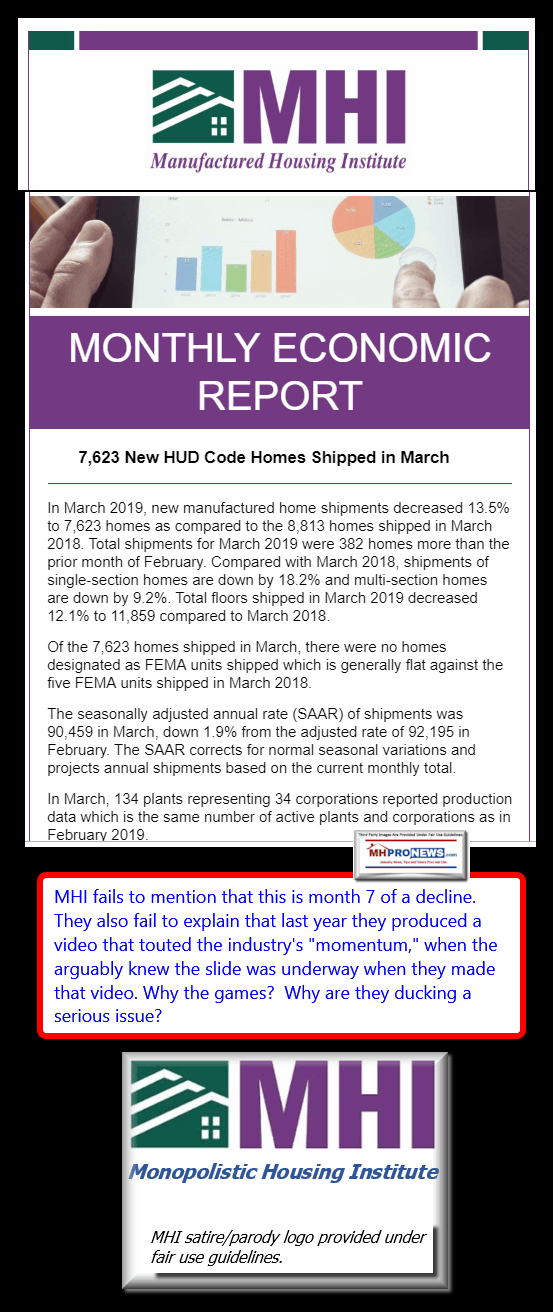
The data above sums up what MHI’s own flatly stated report, without presenting a solution to the problems that their own slogan indicates lies in their purvey.
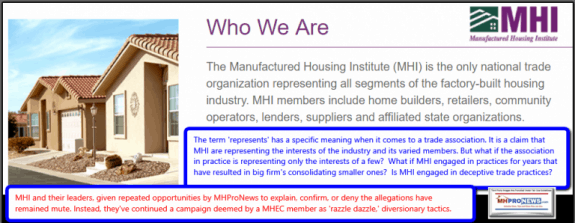
MHARRR’s analysis of HUD Data revealed that 8 of the 10 of the top ten states in manufactured housing shipments are behind in year-over-year totals.
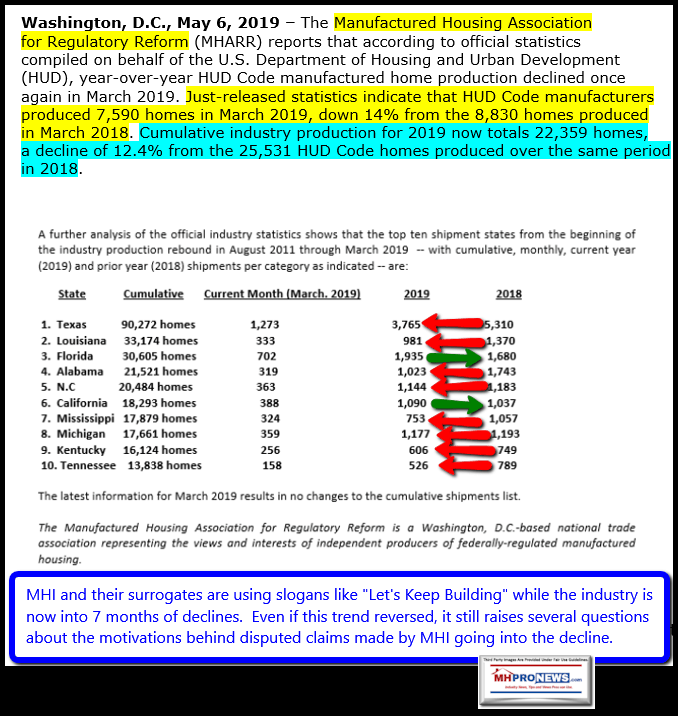
But somehow, MHI managed to claim in their late 2018 self-promotional video that they had ‘momentum’ – which is true, if they meant reverse momentum. Or momentum in the sense that more consolidation is underway.

That’s our second look today at “News through the lens of manufactured homes, and factory-built housing,” © where “We Provide, You Decide.” © ## (News, analysis, and commentary.)

Your link to industry praise for our coverage, is found here.
For the examples of our kudos linked above…plus well over 1,000 positive, public comments, we say – “Thank You for your vote of confidence.”
“We Provide, You Decide.” © ## (News, analysis and commentary.)
(Image credits and information are as shown above, and when provided by third parties, are shared under fair use guidelines.)
Submitted by Soheyla Kovach to the Daily Business News for MHProNews.com.

2) To pro-vide a News Tips and/or Commentary, click the link to the left. Please note if comments are on-or-off the record, thank you.
3) Marketing, Web, Video, Consulting, Recruiting and Training Re-sources

Related Reports:
You can click on the image/text boxes to learn more about that topic.
Prosperity Now, Nonprofits Sustain John Oliver’s “Mobile Homes” Video in Their Reports
Multibillion Dollar Opportunities Knock in Solving Affordable Housing Crisis – Masthead L. A. ‘Tony’ Kovach
In a truly free enterprise system, various needs are identified. Then a means of profitably yet honestly serving those needs are established. Ideally, both the customer and product/service benefit. The happy customer(s) then tell or send their friends. That pattern repeated often enough yields success. For millions, perception is reality.
MHARR Launches “Fighting Discriminatory Zoning Mandates” Manufactured Housing Project | Manufactured Housing Association Regulatory Reform
Washington, D.C., May 15, 2019 – With manufactured housing producers, retailers and communities offering their best homes (and related consumer protection) ever, and in light of the failure of the ostensible representation of the industry’s post-production sector to fully and effectively advance the marketing, consumer financing and, most importantly, the full acceptance of federally-regulated manufactured housing as the nation’s premiere source of non-subsidized affordable housing and homeownership, the Manufactured Housing Association for Regulatory Reform (MHARR) has launched a new project and initiative to fight selected, especially egregious instances of discriminatory and exclusionary zoning targeting manufactured housing and manufactured housing consumers.
HUD Code Manufactured Home Production Decline Continues, May Updates | Manufactured Housing Association Regulatory Reform
Washington, D.C., May 6, 2019 – The Manufactured Housing Association for Regulatory Reform (MHARR) reports that according to official statistics compiled on behalf of the U.S. Department of Housing and Urban Development (HUD), year-over-year HUD Code manufactured home production declined once again in March 2019.
MHARR Calls on HUD Secretary to End Discriminatory And Exclusionary Zoning of HUD-Regulated Manufactured Homes | Manufactured Housing Association Regulatory Reform
Washington, D.C., April 30, 2019 – The Manufactured Housing Association for Regulatory Reform (MHARR) in an April 24, 2019 communication to U.S. Department of Housing and Urban Development (HUD) Secretary, Ben Carson (copy attached), has called on the Department to federally preempt local zoning ordinances which discriminatorily exclude manufactured homes regulated by HUD pursuant to the National Manufactured Housing Construction and Safety Standards Act of 1974 and the Manufactured Housing Improvement Act of 2000.
“Lead, Follow … Or Get Out of The Way” | Manufactured Housing Association Regulatory Reform
The last decade-plus has not been especially kind to the manufactured housing industry and consumers of affordable housing. The 21 stCentury began with a great deal of promise for the industry and consumers alike.
https://www.manufacturedhomepronews.com/masthead/rope-a-dope-preserving-access-to-manufactured-housing-act-mom-dad-you/
